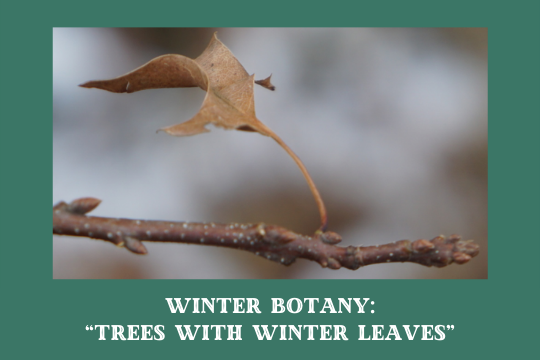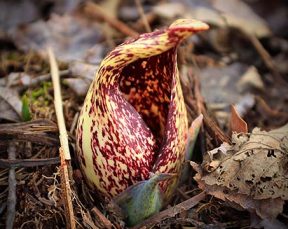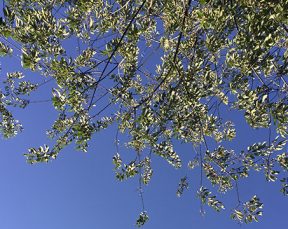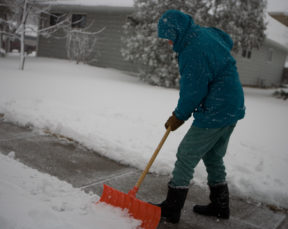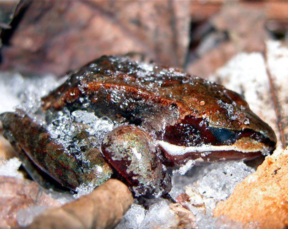By: Kristina Necovska, GSWA Membership, GIS, & Social Media
Wintertime walks are great for a few reasons…you can improve your knowledge of your environment, feel invigorated by the cold, and fight off cabin fever. Learning to identify trees in the winter is not hard and with a bit of practice you’ll understand more about the environment and its history. Contrary to what you might think, Winter is a pretty good time for botany – especially if you want to learn your trees. Most trees drop their leaves in the fall yet there are certain trees that make it even easier for you to recognize them, they are the trees who still wear their leaves through the winter. They’re called marcescent trees and they’re covered in this short blog.
Vocabulary to know
Field guides range from common non-scientific language to highly technical depending on the guide. Learning a few key terms will make life a lot easier.
Leaf arrangements: Plants can have very similar looking leaves and sometimes the difference between two species or families depends on how they arrange their leaves. The following list are not the only leaf arrangements possible, but they are the most common.
Alternate – leaves or twigs are attached on one side of stalk only, ascending on alternating sides up the stem. Example: apple, cherry.
Opposite – Leaves growing opposite from one another from the same point on the stem. Example: maple.
Whorled – Leaves arranged in groups of three or more arising from the same point on the stem (termed a “node”). Example: catalpa.
Basal (for herbaceous plants) – Basal leaves only grow in a rosette at the very base of the plant. As the plant matures, the stem grows from the center of the rosette as a leafless stalk and ends in the inflorescence (the flowering appendage).
Deciduous, evergreen, marcescent
Let’s review some grade school ecology; following the change of available sunlight in the fall, deciduous trees will begin to repurpose nutrients stored in their leaves. Once they have reabsorbed whatever nutrients are still available, they will discard the dead leaf. We call these trees deciduous. Evergreens retain green leaves throughout winter in a marvelous adaptation to take advantage of more available light. Finally, there is a type of deciduous tree we don’t usually hear about; marcescent trees. These trees let their leaves wither away but they still hold onto them until the Spring. They’re “trees with winter leaves.”
Marcescent Trees
Marcescent trees are prone to keeping their leaves in the winter and these are among the easiest to identify. If you witness a tree still wearing its leaves in the wintertime, then chances are that the tree belongs to one of these four types, discussed below; beech (Fagus), hornbeam (Carpinus), or hop-hornbeam (Ostrya), or oak (Quercus).
If the bark is smooth and light gray, with light cream-colored leaves it is American beech (Fagus grandiflora). American beech belongs to the same family as oaks (Fagaceae). North America has only one species of beech occurring in the Northeast. American beech is shade tolerant and is found in rich forests in the final stage of succession. Like oaks, beeches require large amounts of water but can easily drown without good drainage. At age 40, beeches will produce beech nuts which sustain a huge amount of wildlife. The young spring leaves are edible.
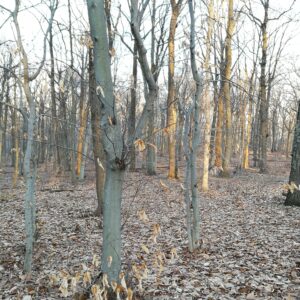

American beech (Fagus grandifolia) with smooth unblemished gray bark, marcescent leaves.


American beech (F. grandifolia) characteristic spine-like buds. Note leaves would be alternate.
If the bark is smooth gray and the wood has pronounced ridges, resembling rippling muscles it is an American hornbeam (Carpinus caroliniana). Hornbeam is a small tree in the birch family (Betulaceae) and native to eastern North America. Its leaves have serrated margins, like beech leaves. Flowers are catkins, like other birches. Carpinus can be found in moderately moist forests and are also shade tolerant – often small understory trees. They are mostly found near streams and swamps.
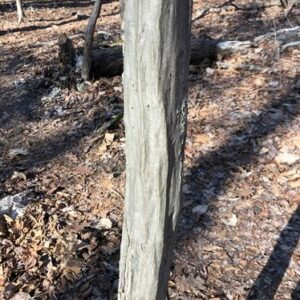

American hornbeam (Carpinus caroliniana) bark. Smooth, greenish gray to gray, with ridges.
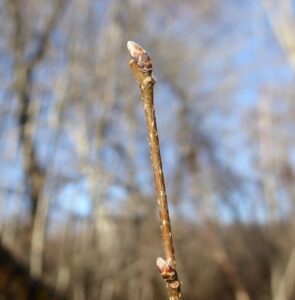

Winter bud of American hornbeam (C. caroliniana). Photo: Elizabeth Byers.
If the tree has bark is covered in peeling rectangular strips, then it is American hop-hornbeam (Ostrya virginiana). Hop-hornbeams are also a close relative of hornbeam in the birch family, and somewhat less common and found in the understory of upland forests. You can confirm the species by looking at its twigs, which are hairy.
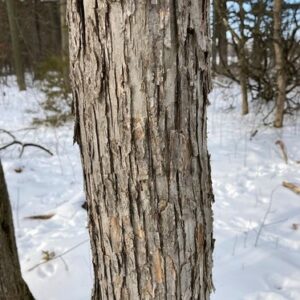

American hophornbeam (Ostrya virginiana) bark.
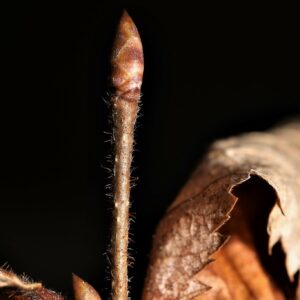

American hornbeam (O. virginiana) twig with characteristic hairs and buds. Photo: Paul Marcum.
Finally, many oaks hold onto their leaves into the winter. Younger oaks are more prone to keep their leaves than older oaks. However, there is no easy rule of thumb to sort them out! Identifying oaks can be quite difficult and requires attention to leaves, bark, habitat, and acorns. But generally, many of us are already familiar with the oak leaf with its many lobes either pointed or round. Oak bark can be ridged, warty, and usually rough, but it changes as the oak matures. Their winter buds can be quite irregular in appearance. Below is a young pin oak (Quercus palustris), which has characteristic “pins” at the end of its leaf lobes.
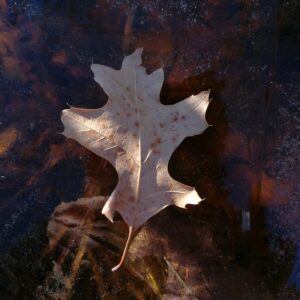

Pin oak leaf (Quercus palustris)
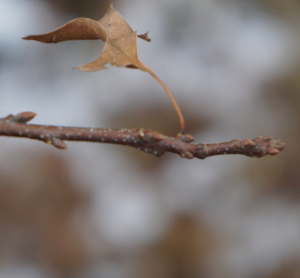

Pin oak twig with irregular buds and attached leaf. Photo Credit: Sara Rall.
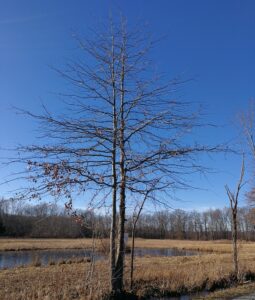

Young pin oak with some marcescent leaves (Quercus palustris) at the Great Swamp National Wildlife Refuge, Tour Road.
What About Other Trees?
One easy rule-of-thumb which helps one remember trees with opposite leaves is the mnemonic device “MAD Horse Bucking”.
Maple (Acer), Ash (Fraxinus), Dogwood (Cornus), Horse chestnut (Aesculus), and Buckthorn (Rhamnus, introduced from Europe and invasive in our area). It’s not comprehensive, but it’s an easy way to remember that a tree with opposite leaves might be one of these. These will be discussed in more detail next time. Until then, happy winter walking!
Sources:
Audubon Society Field Guide to North American Trees, Eastern Region.
Flora of the Southern and Mid-Atlantic States, Alan S. Weakley http://herbarium.unc.edu/flora.htm
All photos credit to author unless otherwise noted.
